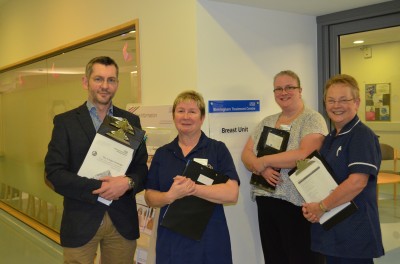
The team from an award-winning NHS breast unit is using an innovative tool to make improvements by viewing the service through a patient’s eyes.
The team from the Breast Unit at Sandwell and West Birmingham Hospitals NHS Trust is using the 15 Steps Challenge, developed by the NHS Institute for Innovation and Improvement. The challenge is based on the premise that patients’ impressions of NHS services are made within 15 steps of walking into the clinic or ward.
The challenge focuses on seeing care through a patient’s eyes and exploring their first impressions. It aims to identify what is working well and what could be better, highlighting what NHS staff may overlook, with a senior clinician working with other clinical staff and a patient. The 15 Steps Challenge team walk through the clinic environment from start to finish, observing what it is like from a patient’s perspective, with observation guides to help structure their thoughts and observations. The challenge takes in all aspects of the patient journey, from car parking, the entrance and booking in to waiting areas, toilets and corridors.
It is the first time that the 15 Steps Challenge has been used at the Trust and it is hoped that more services will now also take on the task.
Martin Sintler, Consultant Breast and General Surgeon and Clinical Lead for Breast Surgery, led the challenge in the unit. He said: “Patients, services users and their families and carers very quickly know whether they feel confident about the service they are visiting, and as clinicians we want to make sure that their experience is as good as possible. After walking the patient path, we will now draw up a potential action plan to improve some of the things that the challenge has highlighted and then repeat at a later stage to see how the patient experience has been improved.”
Sister Marion Mitchell, who took part in the challenge with Mr Sintler, said: “We have found the challenge to be really useful. The intention is to carry on doing this exercise, alongside patients, so that we really understand the patient perspective and what changes we can make. The changes may be small things, such as signage, up to date information being available or how people are greeted, but they can make a huge difference to our patients.”

